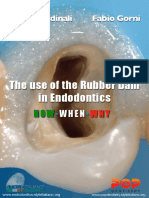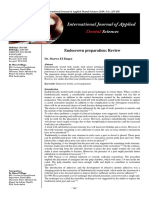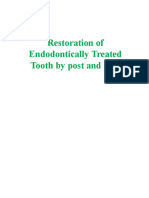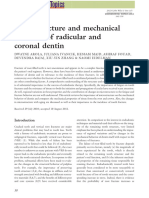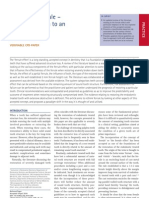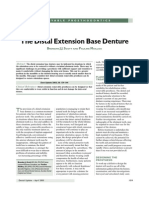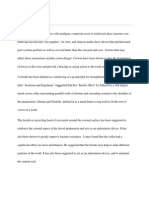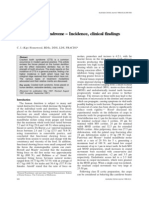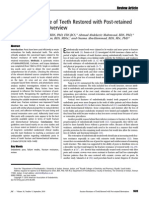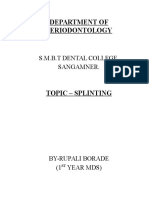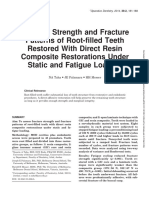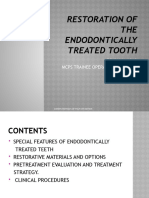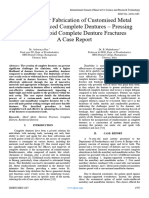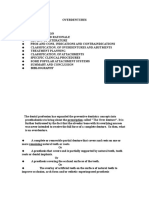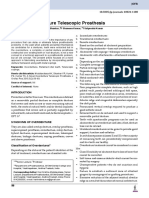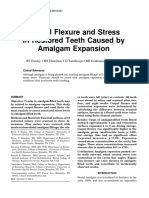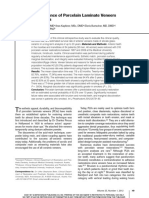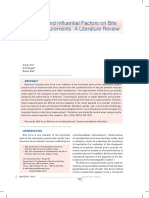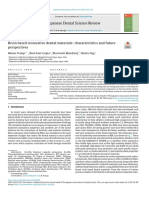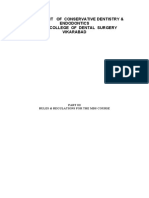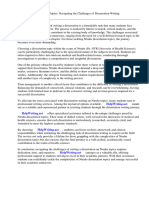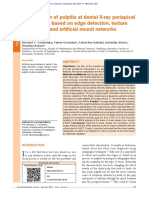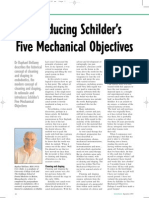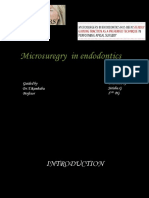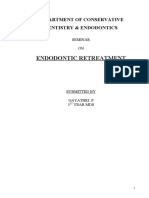Biomechanical Considerations in Restoring Endodontically Treated Teeth-Assif1994
Biomechanical Considerations in Restoring Endodontically Treated Teeth-Assif1994
Uploaded by
Dan MPCopyright:
Available Formats
Biomechanical Considerations in Restoring Endodontically Treated Teeth-Assif1994
Biomechanical Considerations in Restoring Endodontically Treated Teeth-Assif1994
Uploaded by
Dan MPOriginal Title
Copyright
Available Formats
Share this document
Did you find this document useful?
Is this content inappropriate?
Copyright:
Available Formats
Biomechanical Considerations in Restoring Endodontically Treated Teeth-Assif1994
Biomechanical Considerations in Restoring Endodontically Treated Teeth-Assif1994
Uploaded by
Dan MPCopyright:
Available Formats
Biomechanical considerations in restoring endodontically
treated teeth
David Amif, DMD,a and Colin Gorfil, BDS (Rand)b
The Maurice and Gabriela GoldschlegerSchool of Dental Medicine, Tel Aviv University, Tel
Aviv, Israel
Various concepts for dental treatment have been established without appropriate
documentation, such as restoration of endodontically treated teeth. Some research-
ers and dentists strongly recommend including a post with the restoration to
strengthen the root. Other studies have indicated that posts may substantially
weaken the roots and should be avoided. An additional approach suggested that the
post did not improve the resistance to fracture during occlusion and did not support
the restoration. Biomechanical problems are analyzed, and a recommended clinical
approachiis presented.(J PROSTHET DENT 1994;71:565-7.)
M any dentists have successfully treated patients Dentin provides a solid base required for the restoration
by means of empiric methods that are not supported by of a tooth, and the structural strength of a tooth depends
sound longitudinal studies. All prosthodontic treatment on the quantity and inherent strength of dentin and the
without exception exacts its “biological price.” Concepts integrity of its anatomic form. After endodontic therapy
for restoring pulpless teeth have been formed from clinical there is an appreciable loss of dentin including anatomic
observation rather than valid scientific investigation. En- structures, cuspal ridges, and the arched roof of the pulpal
dodontically treated teeth present numerous problems be- chamber. This results from restorative or endodontic tech-
cause of coronal destruction from dental caries, fractures, niques that rarely preserve dentin. The fundamental
and previous restorations or endodontic techniques. The problem is the quantity of healthy dentin remaining to re-
result is loss of tooth structure and a reduction in the ca- tain the restoration.
pability of the tooth to resist a myriad of intraoral forces. An increase in the incidence or prevalence of fractures of
Most of the literature concerning restoration of endo- pulpless teeth has been observed clinically, but there have
dontically treated teeth has focused on the post-core unit. been few investigations designed to solve the problem.
The post is inserted in a root canal, and the core is retained Many dentists assume that endodontically treated teeth
by an apical extension and supports the coronal portion are weakened and more prone to fracture because of des-
that simulates a Iprepared tooth to sustain a definite cast iccation or premature loss of fluids supplied by vital pulps.
restoration.le4 This assumption is based on the research of Helfer et al.6
The traditional objective for a post was to strengthen the who reported that there was approximately 10% less col-
weakened tooth. It was assumed that there was a basic lagen-bound water in the tooth. Three years previously
change in the dentin of the pulpless tooth, and immediate Fusayama and Maedal demonstrated that there were no
steps were suggested to strengthen the tooth and improve changes in the modulus of elasticity, hardness, or fracture
resistance to occ:lusal forces. However, these techniques toughness of pulpless teeth. The direct relationship be-
commonly weaken the tooth. tween the amount of remaining coronal tooth structure and
Posts and cores are commonly advocated to (1) protect the ability of the tooth to resist occlusal forces was demon-
or strengthen the tooth against intraoral forces by equally strated in 1956 by Vale,8 followed by Larson et al9 and
distributing torquing forces within the radicular dentin to Mondelli et al.‘O As more tooth structure was removed, the
supporting tissues, thus dispersing the forces along the resistance to occlusal forces was diminished and the possi-
root, and (2) provide retention for the core that replaced bility of fracture increased.
lost coronal tooth structure and retain the restoration.3, 5 Similar results appeared in the literature relating to re-
The validity of these assumptions and the capability of the moval of dentin from a root canal in preparation for a metal
post to provide these essential functions were examined. post. Trope et al.” showed that preparation of the canal
weakened the root and decreased its ability to withstand
forces before insertion of a metal post, and the post further
increased the risk of fracture. These results explained the
Winical Professor,Section of Oral Rehabilitation. data repeated in numerous experiments, where intact
bSeniorClinical Lecturer, Section of Operative Dentistry.
Copyright @1994by The Editorial Council of THE JOURNAL OF pulpless teeth without intraradicular “strengthening” op-
PROSTHETIC DmmmY. posed occlusal forces better than teeth “strengthened” by
0022-3913/94/$3.00+0. 10/l/62792 various posts.12The increase in coronal fractures of endo-
JUNE 1994 565
THE JOURNAL OF PROSTHETIC DENTISTRY ASSIF AND GORFIL
noAnal stress a0
I
Fig. 1. Stress distribution across root in tooth under load. F, Force applied on lingual
surface of tooth. Fulcrum (lower vertical arrow) is on buccal surface and corresponds to
crest of alveolar bone. T, tensile stresses; C, compressive stresses. C and T are maximal at
external surface of root and decrease to zero at center of root or canal (only available place
for post insertion). Center of root or canal is neutral area with regard to force concentra-
tion, and in its given position, post receives minimal stresses under occlusal load and con-
sequently does little to reinforce root under such a load.
dontically treated teeth resulted from the loss of substan- Therefore the post design has limited influence on resis-
tial dentin that included the roof of the pulpal chamber. tance of the tooth to fracturing, and it is not as critical as
Cracks or fractures of roots occurred after endodontic a complete cast crown to brace healthy tooth structure
treatment, especially in those teeth “strengthened” by apical to the core margin.21-25
posts after tooth structure was removed from the cana1.13-17 The metal crown concentrates forces at its margins dur-
Metal posts concentrate unbalanced forces to walls of the ing occlusal loading because of pressure of the crown on the
root. finish line of the tooth preparation when the margin design
The main factor endangering the survival of pulpless is a butt joint type and because of sharp angles that con-
teeth after restoration is loss of dentin during endodontic centrate forces when stressed.26In the metal crown, forces
treatment, while preparing the accesscavity with excessive are concentrated in an area of sharp margins, exerting
widening and additional loss of dentin from post prepara- much pressure on the coronal one third of the root. In the
tion. Therefore it is not necessary to strengthen the tooth, transitional area between a rigid and a less rigid material,
but it is essential not to weaken it unnecessarily! Conser- there is concentration of high stress with increased forces,
vation of dentin is mandatory, and restorations that sup- especially lateral forces. The rigid material or the crown
port this concept are preferable. absorbs more forces and transfers them to the less rigid
Considerable controversy surrounds the need for using material or the tooth.27
coronal-radicular stabilization. There are three basic phi- A post does not noticeably reduce forces at the margins
losophies: (1) Some dentists advocate posts in each tooth of a crown and does not cause a more equal distribution or
after root canal treatment because posts supposedly dispersion of forces along the length of the root.24 There-
strengthen the tooth against occlusal forces.18Tlg (2) Others fore it is questionable whether a post resolves the special
discourage the use of posts claiming that the tooth prepa- needs of the endodontically treated tooth.
ration of the root canal and the insertion of the post results Cylindrical posts have sharp angles at their apical ends,
in substantial weakening of the tooth.l’* I232o (3) A third where forces are concentrated. These posts exert compres-
group believes there is no appreciable improvement in re- sive forces on the root apical to the sharp angles and can
sistance of the tooth to occlusal forces. Use of posts should create dentinal cracks from the tip of the post to the cir-
be avoided when they are not required to provide retention cumference of the root. The preparation of the canal for
for a core.3 this post leaves a thin dentinal wall at the apex of the
Studies conducted directly on post systems are ques- preparation, where concentration of forces is greatest, and
tionable because they do not reflect specific clinical condi- also increases the risk of perforation. Tapered posts exhibit
tions. The core is commonly covered by a complete crown lower concentrations of stress in the apical portion, prob-
with a 2 mm margin on healthy tooth structure, and this 2 ably because of the absence of sharp angles and conserva-
mm bracing provides a ferrule effect that protects the root tion of tooth structures in this area.24,28
against fractures at gingival margins. Lateral forces result in high stress concentrations in
Studies have shown that artificial crowns alter the radicular dentin at the coronal one third of the root.24 The
distribution of forces to roots, and post systems lose signif- rotational axis of the tooth is located at the crest of alve-
icance when the tooth is covered by a complete cast crown. olar bone and the forces are greatest on the circumference
566 VOLUME 71 NUMBER 6
ASSIF AND GORFIL THE JOURNAL OF PROSTHETIC DENTISTRY
of the root, whereas the concentration of the forces is low- 6. Helfer AR, Melnick S, Schilder H. Determination of the moisture con-
tent of vital and pulpless teeth. Oral Surg 1972;34:661-9.
est within the root canal. The center of the root or canal is 7. Fusayama T, Maeda T. Effect of pulpectomy on dentin hardness. J Dent
a neutral area with regard to force concentration. This force Res 1969;48:452.
distribution explains the susceptibility of teeth to fracture 8. Vale WA. Cavity preparation. Irish Dent Rev 1956,2:33-41.
9. Larson TD, Douglas WH, Geistfeld RE. Effect of prepared cavities on
at the cementoenamel junction when lateral forces are ex- the strength of teeth. Oper Dent 1981;6:2-5.
erted on the coronal portion of the tooth. The contribution 10. Mondelli J, Steagsl IL, Ishikiriama A, Navaro M, Soares FB. Fracture
of the post inserted in the root canal or area of zero forces strength of human teeth with cavity preparation. J PROSTHET DENT
1980;43:419-22.
is negligible because the post absorbs only minimal forces 11. Trope M, Malts DO, Transtad L. Resistance to fracture of restored en-
in this position (Fig. 1).20 dodontically treated teeth. Endod Dent Traumatol 1985;1:108-11.
The distribution of forces questions the value of in- 12. Lavdhal PE, Nicholls JI. Pin-retained amalgam cores versus cast gold
dowel cores. J PROSTHET DENT 1977;38:507-14.
traradicular posts and identities the need to introduce 13. Meister Jr F, Lommel TJ, Gerstein H. Diagnosis and possible causes of
techniques that strengthen the external surface of the root. vertical root fractures. Oral Surg Oral &led Oral Pathol1980;49:243-53.
The thickness of the dentinal wall at the root circumfer- 14. Gher ME, Dunlap RM, Anderson MH, Kuhl LV. Clinical survey of
fractured teeth. J Am Dent Assoc 1987;117:174-7.
ence is critical, and there is a direct correlation between the 15. Tamse A. Iatrogenic vertical root fractures in endodonticahy treated
root diameter and the ability of the tooth to resist lateral teeth. Endod Dent Traumatol 1988;4:196-6.
forces and avoid fracture. Therefore it is difficult to accept 16. MO& AS. Vertical root fractures. Oral Surg Oral Med Oral Path01
1990;69:631-5.
treatment that dictates removal of tooth structure from the 17. Testori T, Badino M, Castagnola M. Vertical root fractures in endo-
canal walls during endodontic treatment or positioning of dontically treated teeth: a clinical survey of 36 cases. J Endod 1993;19:87-
a wider post, since increasing the diameter of the post will 90.
18. Trabert KC, Caputo AA, Abu-Rass M. Tooth fracture, a comparison of
not improve retention.2g endodontic and restorative treatment. J Endod 1978;4:341-5.
19. Kantor ME, Pines MS. A comparative study of restorative techniques
CONCLUSION for pulpless teeth. J PROSTHET DENT 1977;38:405-12.
20. Gusy GE, Nicholls JI. In vitro comparison of intact endodontically
The metal post, and efforts to increase its length and di- treated teeth with and without endo-post reinforcement. J PROSTHET
ameter to improve its radicular retention compromises the DENT 1979;42:39-44.
prognosis of the restored tooth. The use of a post to 21. Haag EP, Dwyer TG. A comparative evaluation of three post and core
techniques. J PROSTHET DENT 1982;47:177-81.
strengthen a pulpless tooth to resist occlusal forces is dif- 22. Nayar A, McDonald TR, Turner F, Koth DL. Strength of premolar
ficult to justify and possibly detrimental. For these reasons coronoradicular build-ups restored with cast crowns. J Dent Res
posts should be used only for retention of a core within re- 1982;61:186.
23. Gelfand M, Goldman M, Sunderman EJ. Effect of complete veneer
maining tooth structure when there are no other alterna- crowns on the compressive strength of endodontically treated posterior
tives. In these instances, essential retentive features can be teeth. J PROSTHET DENT 1984;52:635-8.
selected to retain the core, namely, restorations that use a 24. Assif D, Oren E, Marshak BL, Aviv I. Photoelastic analysis of stress
transfer by endodontically treated teeth to the supporting structure us-
core retained by lparapulpal retentive pins in dentin or an ing different restorative techniques. J PROSTHET DENT 1989;61:535-43.
intraradicular post requiring removal of a minimal amount 25. Assif D, Bitenski A, Pilo R, Oren E. Effect of post design on resistance
of specific tooth structure. to fracture of endodontically treated teeth with complete crowns. J
PROSTHET DENT 1993;69:36-40.
All restorations for pulpless teeth require covering the 26. Caputo AA, Standlee JP. Biomechanics in clinical dentistry. 1st ed.
cusps with a complete cast crown having margins that em- Chicago: Quintessence Publishing, 1987:24, 111.
brace sound tooth structure apical to the finish line of the 21. Caputo AA, Standlee JP. Biomechanics in clinical dentistry. 1st ed.
Chicago: Quintessence Publishing, 1987:134.
core.
28. Pao YC, Reinhardt RA. Root stresses with tapered-end post design in
periodontally compromised teeth. J PROSTHET DENT 1987;57:281-6.
REFERENCES 29. Standlee JP, Caputo AA, Hanson EC. Retention of endodontic dowels:
effects of cement, dowel length, diameter, and design. J PROSTHET DENT
1. Barabsn DJ. The restoration of pulpless teeth. Dent Clin North Am 1978;39:401-5.
1967;11:633-53.
2. Perel ML, Muroff FI. Clinical criteria for post and cores. J PROSTHET Reprint requests to:
DENT 1972;28:405..11. DR. DAVID ASSIF
3. Trabert KC, Cooney JP. The endodontically treated tooth. Restorative SECTION OF ORAL REHABILITATION
concepts and techniques. Dent Clin North Am 19&1;28:923-51. THE MAURICE AND GABFUELA GOLDSCHLEGER
4. Colman HL. Restoration of endodontically treated teeth. Dent Clin SCHOOL OF DENTAL MEDICINE
North Am 1979;28:647-62. TEL AVIV UNIVERSITY
5. Sokol DJ. Effective use of current core and post concepts. J PROSTHET TEL AVIV 69978
DENT 1984;52:231.4. ISRAEL
JUNE 1994 567
You might also like
- Filippo Cardinali Fabio Gorni: The Use of The Rubber Dam in EndodonticsDocument78 pagesFilippo Cardinali Fabio Gorni: The Use of The Rubber Dam in EndodonticsMara Bejnariu100% (1)
- A Long-Term Study of 370 Autotransplanted Premolars. Part I. Surgical Procedures and Standardized Techniques For Monitoring HealingDocument11 pagesA Long-Term Study of 370 Autotransplanted Premolars. Part I. Surgical Procedures and Standardized Techniques For Monitoring HealingRudnapon AmornlaksananonNo ratings yet
- Ellinger 1971Document7 pagesEllinger 1971Mohammed TarekNo ratings yet
- Endocrown Preparation. Review PDFDocument4 pagesEndocrown Preparation. Review PDFDan MPNo ratings yet
- Endo 502 MCQs (FINAL)Document12 pagesEndo 502 MCQs (FINAL)mdio mido100% (5)
- Ms-001 (2) Clinical Priv Form Dental 2019Document4 pagesMs-001 (2) Clinical Priv Form Dental 2019Athira RajanNo ratings yet
- Abou Rass1980Document3 pagesAbou Rass1980Emny Carolina HernandrzNo ratings yet
- Sorensen Martinioff 1984 Intracoronal and Cuspal Coverage Restorations in EndoDocument5 pagesSorensen Martinioff 1984 Intracoronal and Cuspal Coverage Restorations in EndoKarloz Meza BlancoNo ratings yet
- Restoration of Endodontically Treated TeethDocument85 pagesRestoration of Endodontically Treated TeethSayak GuptaNo ratings yet
- Biomechanics of Post Core SystemDocument18 pagesBiomechanics of Post Core SystemNourhan IbrahimNo ratings yet
- Single Complete Denture FinalDocument15 pagesSingle Complete Denture FinalVikas Aggarwal100% (1)
- CairoDentalJournal14 23 26 1998Document4 pagesCairoDentalJournal14 23 26 1998Norman Onyx Tardo DagangNo ratings yet
- Criteria For Restorable Endo Teetg - CDA-ADC JournalDocument9 pagesCriteria For Restorable Endo Teetg - CDA-ADC Journalmoji_puiNo ratings yet
- Screenshot 2022-11-29 at 12.04.44 AMDocument111 pagesScreenshot 2022-11-29 at 12.04.44 AMshathaNo ratings yet
- Effect of Crown Lengthening and Ferrule Placement On Static Load Failure of Cemented Cast Post-Cores and CrownsDocument11 pagesEffect of Crown Lengthening and Ferrule Placement On Static Load Failure of Cemented Cast Post-Cores and CrownsLeandroMartinsNo ratings yet
- 05 Goodacre 1994 Review Part 1Document8 pages05 Goodacre 1994 Review Part 1Ana Massiel NarváezNo ratings yet
- Microstructure and MechanicalDocument23 pagesMicrostructure and Mechanicaljdac.71241No ratings yet
- 2016 Salvation of Severely Fractured Anterior Tooth An Orthodontic ApproachDocument4 pages2016 Salvation of Severely Fractured Anterior Tooth An Orthodontic ApproachRajesh GyawaliNo ratings yet
- 1 s2.0 S0099239976801008 MainDocument2 pages1 s2.0 S0099239976801008 Main13eeeNo ratings yet
- An Evidence Based Decision Analysis For Criteria For Selection of Post Endodontic RestorationDocument5 pagesAn Evidence Based Decision Analysis For Criteria For Selection of Post Endodontic RestorationSimona BugaciuNo ratings yet
- Tangsripongkul2020 PDFDocument5 pagesTangsripongkul2020 PDFdrpriyanka patelNo ratings yet
- Reduction Resto ProcedureDocument5 pagesReduction Resto ProcedureAnindyaNoviaPutriNo ratings yet
- Foundation RestorationsDocument15 pagesFoundation Restorationspopat78100% (1)
- Rosen 1961Document14 pagesRosen 1961Fer TorresNo ratings yet
- Rethinking FerruleDocument10 pagesRethinking FerruleteodudeNo ratings yet
- The Prosthodontic Management of Endodontically Treated Teeth - A Literature Review. Part I. SuccesDocument8 pagesThe Prosthodontic Management of Endodontically Treated Teeth - A Literature Review. Part I. SucceskochikaghochiNo ratings yet
- 10 1016@j Prosdent 2020 03 025Document6 pages10 1016@j Prosdent 2020 03 025prostho booksNo ratings yet
- Tensile Stress Distribution in Maxillary Central Incisors Subjected To Various Dental Post and Core ApplicationsDocument8 pagesTensile Stress Distribution in Maxillary Central Incisors Subjected To Various Dental Post and Core ApplicationsAhmed MadfaNo ratings yet
- Single Complete DENTUREDocument7 pagesSingle Complete DENTURESTAR XEROXRMSNo ratings yet
- Indikasi OnlayDocument6 pagesIndikasi Onlayaulia.shafirarahmaNo ratings yet
- 1 s2.0 S0022391307601103 MainDocument10 pages1 s2.0 S0022391307601103 MainPau ContrerasNo ratings yet
- The Distal Extension Base Denture.1 PDFDocument5 pagesThe Distal Extension Base Denture.1 PDFenlighten070% (1)
- Stainless Steel CrownDocument16 pagesStainless Steel CrownDr Pooja RasalNo ratings yet
- Ferrule EffectDocument11 pagesFerrule EffectJaysondeAsisNo ratings yet
- True Vertical Tooth Root Fracture: Case Report and Review: Contemp Clin DentDocument6 pagesTrue Vertical Tooth Root Fracture: Case Report and Review: Contemp Clin Dentshella indriNo ratings yet
- CrackedToothSyndrome 2Document6 pagesCrackedToothSyndrome 2Maheswari SureshNo ratings yet
- Valdez, Gianni Marie Demejes, Beryl Ann Taupa, Monica Jane Mendoza, Hazel Benfit, CaliDocument22 pagesValdez, Gianni Marie Demejes, Beryl Ann Taupa, Monica Jane Mendoza, Hazel Benfit, CaliPeyman DhgNo ratings yet
- FPD - LEC.SAS.8 Chart Factors Influencing Bridge DesignDocument11 pagesFPD - LEC.SAS.8 Chart Factors Influencing Bridge DesignLily Dawn Marquez JoloNo ratings yet
- Molar Access Dcna 1Document26 pagesMolar Access Dcna 1mahmoudNo ratings yet
- 6.clinical Case ReportMultidisciplinary Approach For Rehabilitation of Debilitated Anterior ToothDocument6 pages6.clinical Case ReportMultidisciplinary Approach For Rehabilitation of Debilitated Anterior ToothSahana RangarajanNo ratings yet
- Applegate1960 - The Rationale of Partial Denture Choice.Document17 pagesApplegate1960 - The Rationale of Partial Denture Choice.Zachary DuongNo ratings yet
- Journal of Tics JOE 2010 Issue SeptemberDocument164 pagesJournal of Tics JOE 2010 Issue SeptemberDrPratibha AhirwarNo ratings yet
- Post Endodontic RestorationsDocument162 pagesPost Endodontic Restorationstaha siddiquiNo ratings yet
- SplintingDocument40 pagesSplintingrupaliNo ratings yet
- The Single Complete Denture - A Case Report: Usha M Radke, Sham M Gundawar, Rajlakshmi S Banarjee, Aditi S PaldiwalDocument6 pagesThe Single Complete Denture - A Case Report: Usha M Radke, Sham M Gundawar, Rajlakshmi S Banarjee, Aditi S Paldiwaljinan AlanaziNo ratings yet
- CrownandExtracoronalRestorations EndodWhitworthDocument11 pagesCrownandExtracoronalRestorations EndodWhitworthMitza CristianNo ratings yet
- Evaluation Abutment Tooth:: Prof. Adel Farhan IbraheemDocument12 pagesEvaluation Abutment Tooth:: Prof. Adel Farhan IbraheemMohammad ANo ratings yet
- Restoration of Endodontically Treated TeethDocument194 pagesRestoration of Endodontically Treated TeethBharti DuaNo ratings yet
- Fracture Strength and Fracture Patterns of Root-Filled Teeth Restored With Direct Resin Composite Restorations Under Static and Fatigue LoadingDocument8 pagesFracture Strength and Fracture Patterns of Root-Filled Teeth Restored With Direct Resin Composite Restorations Under Static and Fatigue LoadingLala LalaNo ratings yet
- Restoration of ENDO Treated TeethDocument81 pagesRestoration of ENDO Treated Teethshamsmarwat200No ratings yet
- BELOBROV I 2008 Conservative Treatment of A Cervical Horizontal Root Fracture and A Complicated Crown Fracture A Case ReportDocument5 pagesBELOBROV I 2008 Conservative Treatment of A Cervical Horizontal Root Fracture and A Complicated Crown Fracture A Case ReportaactinoNo ratings yet
- Ferrule EffectDocument5 pagesFerrule EffectnobelcyrilNo ratings yet
- Technique For Fabrication of Customised Metal Mesh Reinforced Complete Dentures - Pressing Need To Avoid Complete Denture Fractures A Case ReportDocument4 pagesTechnique For Fabrication of Customised Metal Mesh Reinforced Complete Dentures - Pressing Need To Avoid Complete Denture Fractures A Case ReportInternational Journal of Innovative Science and Research TechnologyNo ratings yet
- PEAK Restoration of The Endodontically Treated Tooth PDFDocument20 pagesPEAK Restoration of The Endodontically Treated Tooth PDFana9025100% (1)
- Occulasl Consideration For Implant Supported Prostehsi / Orthodontic Courses by Indian Dental AcademyDocument117 pagesOcculasl Consideration For Implant Supported Prostehsi / Orthodontic Courses by Indian Dental Academyindian dental academy100% (2)
- Stainless Steel Crowns in Pediatric Dentistry: A Review ArticleDocument2 pagesStainless Steel Crowns in Pediatric Dentistry: A Review ArticleHasan ZaylaaNo ratings yet
- OVERDENTURESDocument15 pagesOVERDENTURESAditya SavirmathNo ratings yet
- Ebd 305Document5 pagesEbd 305digdouwNo ratings yet
- An Evidence Based Decision Analysis For Criteria For Selection of Post Endodontic RestorationDocument5 pagesAn Evidence Based Decision Analysis For Criteria For Selection of Post Endodontic Restorationjulist.tianNo ratings yet
- A Novel Overdenture Telescopic Prosthesis PDFDocument5 pagesA Novel Overdenture Telescopic Prosthesis PDFdrzana78No ratings yet
- The Effect of Prosthodontic Treatment On Alveolar Bone Loss - A Review of The LiteratureDocument5 pagesThe Effect of Prosthodontic Treatment On Alveolar Bone Loss - A Review of The LiteratureNathawat PleumsamranNo ratings yet
- GTC 1 - Introduction To Fixed Prosthodontics (PPSG Lectures)Document52 pagesGTC 1 - Introduction To Fixed Prosthodontics (PPSG Lectures)rositadewiNo ratings yet
- The Tooth Its Structure and PropertiesDocument18 pagesThe Tooth Its Structure and Propertiesandres schlosserNo ratings yet
- Cuspal Flexure and Stress in Restored Teeth Caused by Amalgam ExpansionDocument8 pagesCuspal Flexure and Stress in Restored Teeth Caused by Amalgam ExpansionPablo BenitezNo ratings yet
- Clinica Performance Laminate Veneers 20 YearsDocument9 pagesClinica Performance Laminate Veneers 20 YearsDan MPNo ratings yet
- Minimally Invasive Treatment Options in Fixed Prosthodontics-Edelhoff 2016Document11 pagesMinimally Invasive Treatment Options in Fixed Prosthodontics-Edelhoff 2016Dan MPNo ratings yet
- Crown and Post-Free Adhesive Restorations For Endodontically Treated Posterior Teeth From Direct Composite To Endocrowns-Stappert 2008Document8 pagesCrown and Post-Free Adhesive Restorations For Endodontically Treated Posterior Teeth From Direct Composite To Endocrowns-Stappert 2008Dan MPNo ratings yet
- Placement of Fiber Prefabricated or Custom Made Posts Affects The 3-Year Survival of Endodontically Treated Premolars-Cagidiaco-3yrpostsurvivalDocument7 pagesPlacement of Fiber Prefabricated or Custom Made Posts Affects The 3-Year Survival of Endodontically Treated Premolars-Cagidiaco-3yrpostsurvivalDan MPNo ratings yet
- Bite Force and Influential Factors On Bite Force Measurements A Literature Review-Duygu 2019Document10 pagesBite Force and Influential Factors On Bite Force Measurements A Literature Review-Duygu 2019Dan MPNo ratings yet
- Biomechanical Considerations For The Restoration On Endodontically Treated Teeth. A Systematic Review of The Literature-Part I. Composition and Micro and Macrostructure AlterationsDocument11 pagesBiomechanical Considerations For The Restoration On Endodontically Treated Teeth. A Systematic Review of The Literature-Part I. Composition and Micro and Macrostructure AlterationsGonzalo Bravo Ahumada100% (1)
- A Randomized Controlled Trial of Endodontically Treated and Restored Premolars-Ferrari2012Document8 pagesA Randomized Controlled Trial of Endodontically Treated and Restored Premolars-Ferrari2012Dan MPNo ratings yet
- Resin Based Restorative Dental Materials. Characteristics and Future PerspectivesDocument13 pagesResin Based Restorative Dental Materials. Characteristics and Future PerspectivesDan MPNo ratings yet
- Fiber-Reinforced Resin Coating For Endocrown Preparations.A Technical Report 12-139-trDocument7 pagesFiber-Reinforced Resin Coating For Endocrown Preparations.A Technical Report 12-139-trDan MPNo ratings yet
- Dental Composite Resin. A ReviewDocument7 pagesDental Composite Resin. A ReviewDan MPNo ratings yet
- Biomechanical Behavior of Endocrown Restorations With Different CAD-CAM Materials-A 3D Finite Element and in Vitro Analysis-Ziting 2020Document10 pagesBiomechanical Behavior of Endocrown Restorations With Different CAD-CAM Materials-A 3D Finite Element and in Vitro Analysis-Ziting 2020Dan MPNo ratings yet
- Department of Conservative Dentistry 2009 FinalDocument160 pagesDepartment of Conservative Dentistry 2009 FinalDr. Nikhil saran67% (3)
- Ntruhs Dissertation TopicsDocument4 pagesNtruhs Dissertation TopicsWriteMyPaperCoSingapore100% (1)
- Identification of Pulpitis at Dental X Ray Periapical Radiography Based On Edge Detection, Texture Description and Artificial Neural NetworksDocument7 pagesIdentification of Pulpitis at Dental X Ray Periapical Radiography Based On Edge Detection, Texture Description and Artificial Neural Networksjulist.tianNo ratings yet
- 5 MechobDocument2 pages5 MechobNirav MehtaNo ratings yet
- Link Buku KonservasiDocument2 pagesLink Buku Konservasisiti rachmatiara dwiNo ratings yet
- Micro CT Assessment of Gap Containing ArDocument13 pagesMicro CT Assessment of Gap Containing ArMarin TheodorNo ratings yet
- Accidents in Endodontic A Case ReportDocument4 pagesAccidents in Endodontic A Case ReportDr.O.R.GANESAMURTHINo ratings yet
- Velasco V NibreDocument15 pagesVelasco V Nibregfrancisco050% (1)
- Minimally Invasive Endodontics: A New Era For Pulpotomy in Mature Permanent TeethDocument7 pagesMinimally Invasive Endodontics: A New Era For Pulpotomy in Mature Permanent TeethyoiNo ratings yet
- Parker Et Al-2017-International Endodontic JournalDocument7 pagesParker Et Al-2017-International Endodontic JournalSinaivNo ratings yet
- Delta Dental BasicDocument29 pagesDelta Dental BasicTimNo ratings yet
- Materials Needed: Oral Diagnosis Pediatric Dentistry: RestoDocument2 pagesMaterials Needed: Oral Diagnosis Pediatric Dentistry: RestoAisha AldossaryNo ratings yet
- Pulp Diagnosis Current Guidelines Shortcomings and Future DevelopmentsDocument5 pagesPulp Diagnosis Current Guidelines Shortcomings and Future DevelopmentsKarma YogaNo ratings yet
- Seminar 12 - Microsurgery in Endodontics 2Document65 pagesSeminar 12 - Microsurgery in Endodontics 2syed waliNo ratings yet
- Case Report: Overhanging Fillings in Restorative Dental Treatments and EndodonticsDocument5 pagesCase Report: Overhanging Fillings in Restorative Dental Treatments and EndodonticsKarissa NavitaNo ratings yet
- 07 Endodontic RetreatmentDocument64 pages07 Endodontic RetreatmentGayathriNo ratings yet
- International Journal of Dental Science and Innovative Research (IJDSIR)Document8 pagesInternational Journal of Dental Science and Innovative Research (IJDSIR)sneha vaswaniNo ratings yet
- The Microbial Challenge To Pulp Regeneration: A.F. FouadDocument5 pagesThe Microbial Challenge To Pulp Regeneration: A.F. FouadMaria Isabel XochihuaNo ratings yet
- Methods of Diagnosis and Treatment in Endodontics: A Systematic ReviewDocument383 pagesMethods of Diagnosis and Treatment in Endodontics: A Systematic Reviewامير كاظم علي حسينNo ratings yet
- Int Endodontic J - 2022 - Clauder - Present Status and Future Directions Managing PerforationsDocument20 pagesInt Endodontic J - 2022 - Clauder - Present Status and Future Directions Managing Perforationsjorge2412No ratings yet
- Single Visit Endodontic TherapyDocument95 pagesSingle Visit Endodontic TherapyAshish Bhadane100% (2)
- Nagarjun Endo PerioDocument156 pagesNagarjun Endo Periorasagna reddy100% (1)
- Post Op Instructions Root CanalDocument2 pagesPost Op Instructions Root CanalOke Soe MoeNo ratings yet
- Full Book PDFDocument207 pagesFull Book PDFsrinivasanNo ratings yet

